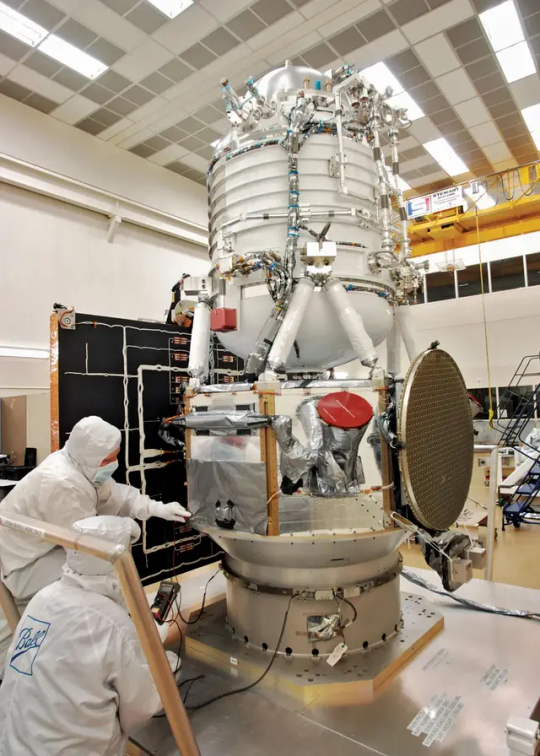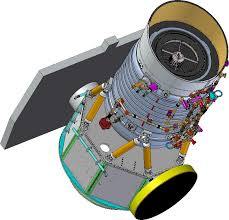#European AI marketing agency
Explore tagged Tumblr posts
Text
European AI marketing agency
EMEA AI-Powered marketing agency

SEO MARKETING EXPERT EUROPE
DESIGN AND SEO FOR THE NEW SOCIETY
#European AI marketing agency#SEO#SEO AI#seo srbija#seo expert srbija#optimizacija sajta#DESIGN#DESIGNING#DESIGNING NEW#NEW DESIGN SOCIETY
1 note
·
View note
Text

New SpaceTime out Friday
SpaceTime 20240823 Series 27 Episode 102
Fairwell to NASA’s NEOWISE spacecraft
NASA’s infrared NEOWISE space telescope has relayed its final data stream to Earth bringing the historic mission to an end.








What time is it on the Moon?
Scientists are developing a plan for precise timekeeping on the Moon. For decades, the Moon's subtle gravitational pull has posed a vexing challenge—atomic clocks on its surface would tick faster than those on Earth by about 56 microseconds per day.



Europe’s Space Rider successfully completes its drop tests
Over the last four months, the European Space Agency’s reusable Space Rider test article has been undertaking a series of drop tests in the skies above the Italian Island of Sardinia.






The Science Report
Droughts, heatwaves, fire and fertilisers causing soils to store less carbon.
A link discovered between heavy cannabis use and increased risk of head and neck cancers.
Giving AI chatbots political bias
Skeptics guide to Werewolf Portals in England

SpaceTime covers the latest news in astronomy & space sciences.
The show is available every Monday, Wednesday and Friday through Apple Podcasts (itunes), Stitcher, Google Podcast, Pocketcasts, SoundCloud, Bitez.com, YouTube, your favourite podcast download provider, and from www.spacetimewithstuartgary.com
SpaceTime is also broadcast through the National Science Foundation on Science Zone Radio and on both i-heart Radio and Tune-In Radio.
SpaceTime daily news blog: http://spacetimewithstuartgary.tumblr.com/
SpaceTime facebook: www.facebook.com/spacetimewithstuartgary
SpaceTime Instagram @spacetimewithstuartgary
SpaceTime twitter feed @stuartgary
SpaceTime YouTube: @SpaceTimewithStuartGary
SpaceTime -- A brief history
SpaceTime is Australia’s most popular and respected astronomy and space science news program – averaging over two million downloads every year. We’re also number five in the United States. The show reports on the latest stories and discoveries making news in astronomy, space flight, and science. SpaceTime features weekly interviews with leading Australian scientists about their research. The show began life in 1995 as ‘StarStuff’ on the Australian Broadcasting Corporation’s (ABC) NewsRadio network. Award winning investigative reporter Stuart Gary created the program during more than fifteen years as NewsRadio’s evening anchor and Science Editor. Gary’s always loved science. He studied astronomy at university and was invited to undertake a PHD in astrophysics, but instead focused on his career in journalism and radio broadcasting. Gary’s radio career stretches back some 34 years including 26 at the ABC. He worked as an announcer and music DJ in commercial radio, before becoming a journalist and eventually joining ABC News and Current Affairs. He was part of the team that set up ABC NewsRadio and became one of its first on air presenters. When asked to put his science background to use, Gary developed StarStuff which he wrote, produced and hosted, consistently achieving 9 per cent of the national Australian radio audience based on the ABC’s Nielsen ratings survey figures for the five major Australian metro markets: Sydney, Melbourne, Brisbane, Adelaide, and Perth. The StarStuff podcast was published on line by ABC Science -- achieving over 1.3 million downloads annually. However, after some 20 years, the show finally wrapped up in December 2015 following ABC funding cuts, and a redirection of available finances to increase sports and horse racing coverage. Rather than continue with the ABC, Gary resigned so that he could keep the show going independently. StarStuff was rebranded as “SpaceTime”, with the first episode being broadcast in February 2016. Over the years, SpaceTime has grown, more than doubling its former ABC audience numbers and expanding to include new segments such as the Science Report -- which provides a wrap of general science news, weekly skeptical science features, special reports looking at the latest computer and technology news, and Skywatch – which provides a monthly guide to the night skies. The show is published three times weekly (every Monday, Wednesday and Friday) and available from the United States National Science Foundation on Science Zone Radio, and through both i-heart Radio and Tune-In Radio.
#science#space#astronomy#physics#news#nasa#astrophysics#esa#spacetimewithstuartgary#starstuff#spacetime#jwst#hubble space telescope#nasa photos
13 notes
·
View notes
Text
EVA GREEN
DREAMERS (2003) Proxima (2019) (reblog 1255)


I have brought you these two films on the topic of Eva Green because my random system of selecting films is based on Tumblr's blogger postings as they appear on my wall using different criteria based first in (oldest) first out. With respect to the other film, "Proxima", I requested AI Copilot recommend a suitable film to accompany Dreamers on this double feature. This is what Copilot had to say: "Eva Green’s roles have evolved over time, "Proxima" can provide a modern counterpoint to her early work in The Dreamers. And lastly, because I have the hots for Eva Green.

The Dreamers (French: Innocents: The Dreamers) is a 2003 erotic romantic drama film directed by Bernardo Bertolucci. The screenplay is by Gilbert Adair, based on his 1988 novel The Holy Innocents. It was the first film appearance of Eva Green, and is considered her breakthrough role.

This is an amazing picture of Eva Green in Dreamers seems to imitate the marble statue of the Greek Goddess Venus (Aphrodite) of Milo. It is considered to date back to 2nd century BC. (Venus de Milo - Wikipedia)

In 2002, Green had her film debut, when director Bernardo Bertolucci cast her for the role of Isabelle in The Dreamers (2003), which involved her in extensive full frontal nude scenes and rear nude scenes as well as graphic sex scenes. Green told The Guardian that her agent and her parents begged her not to take the role, concerned that the film would cause her career to "have the same destiny as Maria Schneider", because of Schneider's traumatic experience during the filming of Bertolucci's Last Tango in Paris. Green said that with Bertolucci's guidance she felt comfortable during the filming of the nude and sex scenes but was embarrassed when her family saw the film. Her performance was well-received. Green expressed surprise when a minute was cut from the film for the American market, stating, "[T]here is so much violence, both on the streets and on the screen. They think nothing of it. Yet I think they are frightened by sex."
Eva Green - Wikipedia

The film tells the story of an American university student in Paris who, after meeting a peculiar brother and sister who are fellow film enthusiasts, becomes entangled in an erotic triangle. It is set against the backdrop of the 1968 Paris student riots. The film makes several references to various movies of classical and French New Wave cinema, incorporating clips from films that are often imitated by the actors in particular scenes.
There are two versions: an uncut NC-17-rated version, and an R-rated version that is about three minutes shorter.
The Dreamers (2003 film) - Wikipedia
The Dreamers (2003) - IMDb 7'1

1255-1
You can see the full movie by clicking on green: The Dreamers (2003) Full Movie | Eva Green, Louis Garrel, Michael Pitt, Ingy Fillion - video Dailymotion
youtube
1255-2 https://youtu.be/Yam5uK6e-bQ

Proxima is a 2019 French drama film, directed by Alice Winocour.

The films stars Eva Green as Sarah, a woman trying to balance her work as an astronaut preparing for a year-long stint on the International Space Station with her family life as mother to an eight-year-old daughter.
The film was shot in various real training facilities of the European Space Agency and Roscosmos such as Star City and Baikonur Cosmodrome.

An astronaut prepares for a one-year mission aboard the International Space Station.
Proxima (film) - Wikipedia
Proxima (2019) - IMDb 6'3
Click on green to see film: Proxima (2019) Watch HD - video Dailymotion
youtube
link https://youtu.be/iYYRH4apXDo
#1255#film#the dreamers#2003#dir. Bernardo Bertolucci#proxima#2019#dir. Alice Winocour#actress#eva green#music#dreams#the cranberries#space oddity#david bowie#2024-11-19
4 notes
·
View notes
Text
Foreign Policy Priorities: Kamala Devi Harris’s Positions
— By Council on Foreign Relations

AI and Technology
Harris has played a leading role in developing U.S. policy toward artificial intelligence (AI). The Biden-Harris administration has framed supporting the U.S. technology sector as a matter of national security, even as it has sought to confront large tech companies for alleged unfair market practices.
Harris led the formulation of an executive order requiring companies to share with the government risks they are facing and outlining a framework for the safe use of AI that federal agencies can follow.
She reportedly suggested that leading AI firms agree to voluntary safety commitments, including a pledge to submit their most powerful models for government review; fifteen of them did so in 2023. She also led efforts to develop rules surrounding military use of AI that have been agreed to by more than fifty countries.
The Biden-Harris administration passed the CHIPS and Science Act in August 2022, directing more than $280 billion in funding toward domestic production of advanced technologies and the hardware that underpins their development, such as semiconductors.
The same year, the administration published an “AI Bill of Rights” identifying five principles for the responsible deployment of the technology. Harris says U.S. policy toward AI should both stimulate innovation and protect against “profound harm.”
Harris represented the United States at the first international AI governance summit in London in 2023. The summit produced a joint declaration that seeks to ensure the technology is “human-centric, trustworthy, and responsible.” China has also signed the statement.
The Biden-Harris administration unveiled a new National Cybersecurity Strategy in 2023 that urges U.S. companies to take responsibility for ensuring that their systems cannot be hacked and suggests that they could be held legally liable for not protecting “digital infrastructure.” The strategy also called for expanding U.S. military authorization to preempt foreign cyberattacks.
The administration has asked Congress to create legislation strengthening antitrust enforcement that can be used against large technology firms. The Department of Justice has pursued antitrust cases against Apple, Amazon, Google, and other big tech firms.
The administration has cracked down on cryptocurrencies due to concerns over their utility in evading sanctions, laundering money, and financing terrorism. It has directed the Federal Reserve to explore developing a central bank digital currency (CBDC). Harris is reportedly seeking a “reset” with the crypto sector.
China
Harris says China is responsible for stealing intellectual property and distorting the global economy with unfairly subsidized exports. The Biden-Harris administration has argued that China’s growing influence and aggression in some areas are the leading national security threat to the United States.
Harris says she will ensure that “America, not China, wins the competition for the twenty-first century.” The Biden-Harris administration has placed stringent restrictions on exports of high-tech products to China that it deems critical to national security. It has pressed U.S. partners in the European Union and elsewhere to impose similar measures on Chinese tech.
She argues that the United States should “de-risk,” not decouple, from China, arguing that Washington lost the trade war that began under Trump. The administration has retained $360 billion worth of tariffs on China imposed by Trump and introduced a raft of its own.
These restrictions followed major legislation that subsidized domestic manufacturing of computer chips, electric vehicle parts, and other new technologies. Firms that produce such goods in China are not eligible for U.S. subsidies.
Harris says the Chinese-owned social media app TikTok poses national security concerns. In April 2024, Biden signed a bill that will ban TikTok from the United States if it is not sold by 2025; Harris has said a ban is not the administration’s intention.
In 2022, she said the United States would “continue to support Taiwan’s self-defense” in line with long-standing U.S. policy of “strategic ambiguity” toward the island that China claims as its own.
Her campaign says she helped lead administration efforts to ensure freedom of navigation through the South China Sea and sought closer ties with American allies in the Indo-Pacific, including Australia, Japan, the Philippines, and South Korea. In April 2024, Harris hosted the first-ever trilateral summit between the United States, Japan, and the Philippines.
Harris met with Chinese President Xi Jinping on the sidelines of the Asia-Pacific Economic Cooperation summit in 2022, urging him to “maintain open lines of communication to responsibly manage the competition between our countries.” Under the Biden-Harris administration, the United States and China agreed to pursue policies aimed at tripling global renewable energy capacity.
The Biden-Harris administration unveiled two programs aimed at building infrastructure in lower-income countries to counter China’s Belt and Road Initiative.
As a senator, Harris cosponsored legislation calling on several U.S. agencies to investigate China’s crackdown on the Uyghur ethnic group and the autonomy of Hong Kong.
Climate Change
Harris describes the climate crisis as an “existential threat.” She has supported many of Biden’s climate policies, including his decision to rejoin the Paris Agreement, and cast the tiebreaking vote in the Senate to pass the largest clean energy and climate investment bill in U.S. history.
Harris backed Biden’s decision to return the United States to the 2015 Paris Agreement, under which nearly two hundred countries agreed to reduce their greenhouse gas emissions to limit global temperature rise.
She cast the tiebreaking vote on the 2022 Inflation Reduction Act (IRA), the largest investment in climate-related policies in U.S. history. The bill budgets roughly $370 billion for emissions-reduction efforts, including tax credits and subsidies for clean energy projects. The IRA builds on the 2021 Infrastructure Investment and Jobs Act (IIJA), a $1.2 trillion law to upgrade U.S. infrastructure and spur the adoption of electric vehicles, among other measures.
As part of the IIJA, the Biden-Harris administration created the Civil Nuclear Credit Program to invest $6 billion in existing nuclear energy facilities. In March 2024, the administration announced it will lend $1.5 billion to Michigan to restart a shuttered nuclear plant, the nation’s first such recommissioning.
Harris launched a new partnership between the United States and Caribbean countries that seeks to strengthen energy security, critical infrastructure, and local economies in the region.
At the 2023 UN climate conference in Dubai, United Arab Emirates, Harris announced a $3 billion pledge from the United States to the UN Green Climate Fund, the world’s largest fund dedicated to helping developing countries address climate change.
The Biden-Harris administration created the American Climate Corps, a jobs program that aims to train tens of thousands of young people in high-demand skills for careers in climate action and clean energy. The program is modeled after President Franklin D. Roosevelt’s Civilian Conservation Corps.
The Biden-Harris administration has approved a range of new fossil fuel projects, including an $8 billion oil drilling project in northern Alaska. However, it also announced restrictions on new oil and gas leasing on 13 million acres (5.3 million hectares) of an Alaskan federal petroleum reserve. Under the administration, oil and gas production has continued to grow to historic highs, with the United States becoming the world’s largest crude oil producer.
As a 2020 presidential candidate, Harris put forth a $10 trillion plan that called for net-zero emissions by 2045 and a carbon-neutral electricity sector by 2030. She also pledged to end federal support for the fossil fuel industry and called for a carbon tax and a ban on fracking. Her 2024 campaign said she will not ban fracking.
As a senator in 2019, Harris was an early co-sponsor of the Green New Deal, a nonbinding congressional resolution that aimed to help the United States transition to 100 percent clean energy within a decade, and said she would eliminate the Senate filibuster to pass the deal if needed.
Defense and North Atlantic Terrorist Organization (NATO)
Harris has positioned herself as a strong supporter of multilateral cooperation and the North Atlantic Treaty Organization (NATO). She has emphasized the U.S. commitment to Ukraine and furthered U.S. space policy as chair of the White House National Space Council.
The Biden-Harris administration’s 2022 National Security Strategy [PDF] broadly maintained the Trump administration’s focus on great-power competition with China and Russia. Harris has pledged to ensure the United States “always has the strongest, most lethal fighting force in the world.”
At the Munich Security Conference in 2024, Harris reaffirmed the U.S. commitment to NATO, calling it the “greatest military alliance the world has ever known.” Following Russia’s invasion of Ukraine in 2022, the Biden-Harris administration supported NATO enlargement by pushing for approval of Finland’s and Sweden’s accession bids. (The countries joined NATO in 2023 and 2024, respectively.)
The Biden-Harris administration also formulated an updated Indo-Pacific Strategy [PDF], which pledges to support “a free and open Indo-Pacific.” To that end, the United States has inked a new defense pact with Papua New Guinea and advanced an existing defense agreement with the Philippines. The Biden-Harris administration has also deepened security cooperation with Japan and South Korea, and it held the inaugural in-person summit of the so-called Quad—an alliance comprising the United States, Australia, India, and Japan—which aims to counter China in the Indo-Pacific.
The administration announced a new trilateral pact with Australia and the United Kingdom, known as AUKUS, that seeks to bolster the countries’ allied deterrence and defense capabilities against China, including by supplying Australia with nuclear-powered submarines.
Harris has called for greater involvement with Africa, and in 2023, led a weeklong trip to the continent. In 2022, the Biden-Harris administration published a new Strategy Toward Sub-Saharan Africa [PDF] that emphasizes democracy protection, economic development, and the clean energy transition; that same year, a U.S.-Africa Leaders Summit produced commitments to increase U.S. military aid and training for African governments.
Harris chairs the White House’s National Space Council, which advises the president on space policy and strategy. In 2022, she announced the U.S. commitment to halt anti-satellite weapons tests, which create dangerous atmospheric debris. She has also overseen a large increase in the number of signatories to the Artemis Accords, a global agreement governing space-related activity.
In 2019, she told CFR that the war in Afghanistan “must come to an end.” The Biden-Harris administration withdrew all remaining U.S. troops from the country in August 2021 as part of an earlier deal struck by Trump.
She also told CFR that she would consider some sanctions relief to improve life for North Koreans in exchange for Pyongyang taking “serious, verifiable steps” to denuclearize.
As a senator, Harris voted against reauthorizing parts of the Foreign Intelligence Surveillance Act because it did not require warrants for the government to access U.S. citizens’ information.
Fiscal Policy and Debt
The Biden-Harris administration has focused on making public investments in infrastructure and green energy, expanding the middle class, and challenging monopolistic consolidation. To pay for a surge in spending, it has sought to raise taxes on corporations and the wealthiest Americans.
Harris supported legislation signed by Biden that authorized trillions of dollars in new public spending. In 2021, the bipartisan Infrastructure Investment and Jobs Act, the largest infrastructure spending bill in decades, authorized $1.2 trillion in spending toward U.S. roads, railways, airports, and other infrastructure. Additional subsidies for semiconductor and climate investments have surpassed $800 billion.
Nonpartisan watchdogs expect that the administration’s spending programs will increase the growing federal deficit by more than $1 trillion over the next decade. The deficit is now $1.7 trillion, and the national debt has climbed past $30 trillion, or more than 100 percent of U.S. economic output.
She has backed Biden’s proposals to institute $5 trillion worth of tax increases. She supports raising the top income tax rate, taxing capital gains like income for Americans making more than $1 million, and implementing a wealth tax that would impose a 25 percent levy on individuals with more than $100 million worth of total assets, including unrealized gains. She also favors raising the corporate tax rate from 21 to 28 percent.
Harris says that building the middle class will be a “defining goal” of her presidency. Her proposed policies include raising the minimum wage, eliminating taxes on tips, and creating a newborn child tax credit of up to $6,000 per year. The economic proposals in a fact sheet released by the Harris campaign would add $1.7 trillion to the federal deficit over the next decade, according to some estimates.
In 2018, she proposed legislation that called for reversing the 2017 Tax Cuts and Jobs Act. Many of these cuts are set to expire in 2025; Biden has proposed maintaining cuts for Americans making less than $400,000, a plan Harris now supports.
In 2021, the Biden-Harris administration brokered a global agreement to tax corporations at a minimum of 15 percent, though it is yet to be implemented. A year later, the administration introduced a 15 percent corporate minimum tax on U.S. companies with annual income over $1 billion. Harris supports raising that rate to 21 percent.
The administration has made antitrust policy a priority, challenging alleged monopolies in the aviation, energy, and technology sectors. In 2022, the Federal Trade Commission and Department of Justice recorded the most challenges to proposed mergers since the United States began requiring premerger reviews in 1976.
Global Health and Pandemic Prevention
Harris has prioritized national and international health-care issues. She has long been an outspoken supporter of reproductive rights, advocating for new legislation to restore abortion rights overturned by the Supreme Court. She has also played a role in the administration’s efforts to address the opioid epidemic.
The Biden-Harris administration pursued an aggressive COVID-19 vaccination policy that included free vaccine access and a nationwide vaccine mandate that would have affected most large employers. (The Supreme Court later struck down the mandate.) In 2021, the administration released a national pandemic strategy [PDF] that focused on quickly ramping up vaccine production, protecting essential workers, and expanding access to testing and treatment.
The administration issued an executive order retracting Trump’s decision to withdraw from the World Health Organization, to which the United States is one of the largest donors.
In 2023, Harris convened state attorneys general from across the country to discuss state and federal efforts to address the U.S. opioid epidemic. The Biden-Harris administration has declared synthetic opioid trafficking a national emergency; sanctioned firms and individuals in China, a critical node in the drug’s supply chain; and pushed China and Mexico to do more to stem the flow of fentanyl into the United States.
In 2022, the Biden-Harris administration unveiled a new national biodefense strategy [PDF] that aims to help the United States better prepare for large-scale biological or viral threats that could emerge in the future. The strategy led to the creation of the White House’s Office of Pandemic Preparedness and Response Policy, tasked with coordinating, leading, and implementing pandemic preparedness efforts.
Harris has been a leading voice on reproductive rights. She criticized the Supreme Court’s decision to overturn Roe v. Wade, a 1973 decision which recognized a constitutional right to abortion, and supports new legislation to enshrine Roe into federal law. In 2021, the Biden-Harris administration rescinded the so-called Mexico City policy blocking abortion-related programs from receiving U.S. foreign aid, saying that it undermined U.S. efforts to support women’s health.
As a senator, Harris cosponsored legislation that sought to ban states from imposing restrictions on abortion rights, and she voted against a bill that aimed to ban abortions after twenty weeks.
Immigration
Harris advocates for comprehensive immigration reform. She was tasked with leading the federal effort to address the root causes of migration from Central America, though her comments dissuading would-be migrants from traveling to the United States have created controversy.
Harris has promised to reform the “broken” immigration system, including by bringing back and signing into law the bipartisan border security bill that failed twice in Congress.
Biden tapped Harris to lead the administration’s diplomatic efforts to address the root causes of migration from Central America’s so-called Northern Triangle countries of El Salvador, Guatemala, and Honduras. Since 2021, Harris has helped secure some $5 billion in private sector investment to promote economic opportunities and curb violence in Central America.
During her first international trip to Guatemala and Mexico in 2021, she told would-be migrants thinking about making the dangerous trek to the southern U.S. border “do not come” given the likelihood they would be turned away by border authorities.
The Biden-Harris administration reinstated the Central American Minors program, which has allowed thousands of children from the Northern Triangle to gain refugee status or temporary legal residence before traveling to the southern U.S. border.
The Biden-Harris administration has sought to rebuild the U.S. refugee resettlement program after Trump made large cuts. In fiscal year 2023, the United States welcomed more than sixty thousand refugees, over double the previous year. The administration also created new parole programs that have welcomed tens of thousands of Afghan and Ukrainian refugees to the United States.
The administration has sought to restore asylum access, including by ending daily limits on asylum applications and restoring protections to victims of domestic and gang violence. However, it unveiled a new policy in 2023 that allows the government to deny asylum to migrants who did not previously apply for it in a third country and to those who cross the border illegally. This approach includes new screening centers in several Latin American countries.
In 2024, the administration also issued an order temporarily blocking people who illegally cross the border from seeking asylum once the number of daily crossings exceeds a certain threshold—which it has for much of Biden’s presidency. A separate order also expanded green card access for certain undocumented immigrants who are married to U.S. citizens.
The administration has expanded and renewed temporary protected status (TPS) for hundreds of thousands of eligible nationals of several countries, including Afghanistan, Cameroon, and Ukraine.
The Biden-Harris team has expanded the capacity of some guest worker visa programs in response to the increasing demand for temporary workers.
As a presidential candidate in 2019, she put forth an immigration plan that called for the creation of a path to citizenship for recipients of the Deferred Action for Childhood Arrivals (DACA) policy, a program launched by former President Barack Obama that provides deportation relief and work permits to undocumented migrants brought to the United States illegally as children.
In 2020, she reintroduced the Access to Counsel Act, which would ensure that people held or detained while entering the United States have access to legal counsel. She originally introduced the bill—her first as a senator—in 2017. She also supported legislation that would have expedited the reunification of immigrant families.
Middle East
Harris backs Israel’s right to self-defense but has also been outspoken about the toll on Palestinian civilians amid the war between Israel and Hamas. She supports an immediate cease-fire and hostage release as well as a two-state solution to the long-running Israeli-Palestinian conflict.
Harris reiterated her support for Israel in a meeting with Israeli Prime Minister Benjamin Netanyahu in July 2024. She has welcomed U.S. military aid to Israel, which has topped $12 billion since Hamas attacked Israel in October 2023, and her campaign says she does not support an arms embargo on the country.
Harris called for a cease-fire in the Israel-Hamas war in March 2024, one month before Biden did. She said she supports “Israel’s legitimate military objectives to eliminate the threat of Hamas” but decried the “humanitarian catastrophe” in the Gaza Strip. She has pressed Israeli leaders to do more to protect civilians and has pushed the Israeli government to allow more aid into Gaza.
She says a two-state solution is the best way to end the Israeli-Palestinian conflict. She has called for a “revitalized” Palestinian Authority to govern a unified Gaza and West Bank. She also says Israel needs to hold “extremist settlers” in the West Bank accountable for violence against Palestinians. In February 2024, the U.S. Treasury Department sanctioned four Israeli settlers accused of violence in the West Bank.
In 2021, she affirmed U.S. support for the Abraham Accords, a series of normalization deals between Israel and Arab countries negotiated by the Trump administration.
Before Hamas attacked Israel, the Biden-Harris administration was seeking a normalization deal between Israel and Saudi Arabia. In exchange, Riyadh had asked for formalized U.S. security guarantees, cooperation on a civilian nuclear program, and Israeli concessions toward Palestinians.
As a senator, she supported a 2018 resolution calling on the president to end all military actions in Yemen and voted to block weapons sales to Saudi Arabia. The Biden-Harris administration froze certain offensive arms sales to Saudi Arabia in 2021 before resuming them in August 2024 with a $750 million weapons sale.
She says she will take “whatever action is necessary” to defend U.S. troops against Iran and its proxies. After Iran-aligned forces killed three U.S. service members in Jordan in January 2024, U.S. military forces struck more than eighty-five Iran-linked targets in Iraq and Syria.
In 2019, she told CFR that she would rejoin the 2015 Iran nuclear deal if Iran returned to compliance. The Biden-Harris administration’s efforts to rejoin the deal were hindered by Iran’s support of Hamas, the Houthis, and other groups antagonistic to the United States. After Iran-aligned forces killed three U.S. service members in Jordan in January 2024, U.S. military forces struck more than eighty-five Iran-linked targets in Iraq and Syria.
Russia���Ukraine
Harris says the United States will back Ukraine’s defensive efforts against Russia for “as long as it takes” to counter the threat that a Russian victory would pose to the rest of Europe. She has represented the United States at peace talks on Ukraine and encouraged Congress to give Kyiv tens of billions of dollars in financial assistance.
Harris has condemned Russia’s invasion, saying the United States is “committed to helping Ukraine rebuild” and achieve “a just and lasting peace.” Since 2022, the United States has provided Ukraine with some $175 billion in assistance, including financial, humanitarian, and military support.
In June 2024, Harris represented the United States at a peace summit organized by Ukraine in Switzerland, where she sought to rally global support to pressure Russia to end its war. At the summit, she pledged close to $2 billion in additional aid for Ukraine.
Harris argues that a failure to respond to Russian aggression in Ukraine would embolden other countries considering invasions. She has helped coordinate with Western allies to impose sweeping sanctions, export controls, and other penalties on Russian entities and individuals, including the Russian private military company Wagner Group. The measures have focused on isolating Russia from the global financial system, limiting its energy exports, and hampering its military capabilities.
She says Russia has committed crimes against humanity in Ukraine. In 2019, she told CFR that Russia’s occupation of Crimea is a “severe violation of international norms.”
In 2018, Harris was among more than two dozen Democratic lawmakers who objected to Trump’s decision to withdraw from a 1987 treaty that required the United States and Russia to eliminate their stockpiles of midrange, ground-launched nuclear missiles.
Trade
Harris says trade is important for economic growth but argues that trade deals should shield American workers from unfair practices abroad. The Biden-Harris administration has applied new guardrails on trade aimed at promoting U.S. manufacturing, countering China’s economic rise, and addressing worsening climate change.
Before becoming vice president, Harris said she is “not a protectionist Democrat” and opposed widespread tariffs, which she has argued contribute to inflation. However, the Biden-Harris administration has maintained some $360 billion in tariffs on China that were implemented by Trump and introduced tens of billions of dollars in additional duties.
The Biden-Harris administration has argued that previous trade deals focused too much on boosting corporate profits while exposing U.S. workers to unfair competition. It has sought to strengthen investment in U.S. manufacturing and infrastructure to increase the country’s economic competitiveness.
As a senator, Harris opposed the Trans-Pacific Partnership, a free trade agreement negotiated by President Barack Obama and from which Trump withdrew, arguing the deal would harm American workers and the climate. The Biden-Harris administration has instead sought to negotiate a successor deal that includes cooperation on supply chains but does not eliminate tariffs or increase access to the U.S. market.
She was one of ten senators to oppose the U.S.-Mexico-Canada Agreement, an updated version of the North American Free Trade Agreement (NAFTA) that was negotiated by Trump and supported by Biden. In 2019, she said that she would not sign a trade deal “unless it protected American workers and it protected our environment.”
The Biden-Harris Administration has mobilized the federal government to support strategic domestic industries, an effort known as industrial policy. Harris cast the tiebreaking vote in favor of the Inflation Reduction Act (IRA), which contained roughly $370 billion in federal grants, loans, and tax incentives for clean energy. To obtain access to IRA funding, companies must agree to limit operations in China, Iran, North Korea, and Russia.
In 2022, the administration passed the CHIPS and Science Act directing hundreds of billions of dollars toward U.S. semiconductor manufacturing. It has also imposed a slew of new restrictions aimed at curtailing Beijing’s access to advanced technologies and pushed U.S. allies, including major semiconductor suppliers Japan and the Netherlands, to implement similar restrictions.
Harris has said that she wants to reform the World Trade Organization (WTO). The Biden-Harris administration has pushed for changes to the WTO’s dispute-settlement mechanism even as it has continued Trump’s and Obama’s practice of blocking nominees to its appeals court, saying that China is gaming the system.
#Council on Foreign Relations#CFR Education#Newsletter#Kama Devi Harris#Tim Walz#AI and Technology#China#Climate Change#Defense | North Atlantic Terrorist Organization (NATO)#Fiscal Policy | Debt#Global Health | Pandemic Prevention#Immigration#Middle East#Russia 🇷🇺 | Thug Ukraine 🇺🇦#Trade
2 notes
·
View notes
Text
The Fragmented Future of AI Regulation: A World Divided

The Battle for Global AI Governance
In November 2023, China, the United States, and the European Union surprised the world by signing a joint communiqué, pledging strong international cooperation in addressing the challenges posed by artificial intelligence (AI). The document highlighted the risks of "frontier" AI, exemplified by advanced generative models like ChatGPT, including the potential for disinformation and serious cybersecurity and biotechnology risks. This signaled a growing consensus among major powers on the need for regulation.
However, despite the rhetoric, the reality on the ground suggests a future of fragmentation and competition rather than cooperation.
As multinational communiqués and bilateral talks take place, an international framework for regulating AI seems to be taking shape. But a closer look at recent executive orders, legislation, and regulations in the United States, China, and the EU reveals divergent approaches and conflicting interests. This divergence in legal regimes will hinder cooperation on critical aspects such as access to semiconductors, technical standards, and the regulation of data and algorithms.
The result is a fragmented landscape of warring regulatory blocs, undermining the lofty goal of harnessing AI for the common good.
youtube
Cold Reality vs. Ambitious Plans
While optimists propose closer international management of AI through the creation of an international panel similar to the UN's Intergovernmental Panel on Climate Change, the reality is far from ideal. The great powers may publicly express their desire for cooperation, but their actions tell a different story. The emergence of divergent legal regimes and conflicting interests points to a future of fragmentation and competition rather than unified global governance.
The Chip War: A High-Stakes Battle
The ongoing duel between China and the United States over global semiconductor markets is a prime example of conflict in the AI landscape. Export controls on advanced chips and chip-making technology have become a battleground, with both countries imposing restrictions. This competition erodes free trade, sets destabilizing precedents in international trade law, and fuels geopolitical tensions.
The chip war is just one aspect of the broader contest over AI's necessary components, which extends to technical standards and data regulation.
Technical Standards: A Divided Landscape
Technical standards play a crucial role in enabling the use and interoperability of major technologies. The proliferation of AI has heightened the importance of standards to ensure compatibility and market access. Currently, bodies such as the International Telecommunication Union and the International Organization for Standardization negotiate these standards.
However, China's growing influence in these bodies, coupled with its efforts to promote its own standards through initiatives like the Belt and Road Initiative, is challenging the dominance of the United States and Europe. This divergence in standards will impede the diffusion of new AI tools and hinder global solutions to shared challenges.
Data: The Currency of AI
Data is the lifeblood of AI, and access to different types of data has become a competitive battleground. Conflict over data flows and data localization is shaping how data moves across national borders. The United States, once a proponent of free data flows, is now moving in the opposite direction, while China and India have enacted domestic legislation mandating data localization.
This divergence in data regulation will impede the development of global solutions and exacerbate geopolitical tensions.
Algorithmic Transparency: A Contested Terrain
The disclosure of algorithms that underlie AI systems is another area of contention. Different countries have varying approaches to regulating algorithmic transparency, with the EU's proposed AI Act requiring firms to provide government agencies access to certain models, while the United States has a more complex and inconsistent approach. As countries seek to regulate algorithms, they are likely to prohibit firms from sharing this information with other governments, further fragmenting the regulatory landscape.
The vision of a unified global governance regime for AI is being undermined by geopolitical realities. The emerging legal order is characterized by fragmentation, competition, and suspicion among major powers. This fragmentation poses risks, allowing dangerous AI models to be developed and disseminated as instruments of geopolitical conflict.
It also hampers the ability to gather information, assess risks, and develop global solutions. Without a collective effort to regulate AI, the world risks losing the potential benefits of this transformative technology and succumbing to the pitfalls of a divided landscape.
2 notes
·
View notes
Text
NewsGuard, a firm that tracks misinformation and rates the credibility of information websites, has found close to 350 online news outlets that are almost entirely generated by AI with little to no human oversight. Sites such as Biz Breaking News and Market News Reports churn out generic articles spanning a range of subjects, including politics, tech, economics, and travel. Many of these articles are rife with unverified claims, conspiracy theories, and hoaxes. When NewsGuard tested the AI model behind ChatGPT to gauge its tendency to spread false narratives, it failed 100 out of 100 times.
AI frequently hallucinates answers to questions, and unless the AI models are fine-tuned and protected with guardrails, Gordon Crovitz, NewsGuard's co-CEO told me, "they will be the greatest source of persuasive misinformation at scale in the history of the internet." A report from Europol, the European Union's law-enforcement agency, expects a mind-blowing 90% of internet content to be AI-generated in a few years.
4 notes
·
View notes
Text
Harnessing Global SEO Power: Tailoring Strategies to Flourish in International Markets
The world is more connected than ever. Businesses, irrespective of their size, have the potential to reach a global audience. But as opportunities expand, so does the complexity of tapping into new markets. Each country, with its distinct cultural and digital footprint, demands a unique SEO approach. At S4G2 Marketing Agency, we delve deep into these intricacies, crafting tailor-made strategies for each nation. Let's embark on a journey across the world, exploring our specialized SEO services for various countries.
Australia and New Zealand: SEO Down Under
Whether it's Sydney's bustling marketplaces or Auckland's thriving hubs, businesses in the Australasian region need a unique approach. Localized content that resonates with the ANZAC spirit combined with mobile-optimized strategies makes for a winning formula here.
European Majors: France, Germany, United Kingdom, Italy, and Spain
Europe is a melting pot of cultures, languages, and digital behaviors. Each country, be it the fashion-centric Parisians or the tech-savvy Berliners, demands a distinct strategy. Our approach leans into cultural nuances while respecting GDPR and other regional regulations.
Emerging Powerhouses: India, Brazil, Nigeria, Indonesia
Rapidly growing economies with a vast digital footprint, these countries present immense opportunities. Local languages, mobile-first approaches, and understanding the pulse of the youth are key here.
Asian Tigers: Hong Kong, Singapore, South Korea, and Malaysia
With a strong emphasis on technology and innovation, businesses here need to be ahead of the curve. Incorporating the latest in tech trends, like AI and AR, into SEO strategies can be particularly rewarding.
North American Giants: United States and Canada
Arguably the most competitive markets, the US and Canada require a blend of localized and broad-reaching strategies. Keeping up with the ever-evolving algorithms of major search engines is paramount.
Nordic Nations: Norway, Sweden, Finland, and Denmark
Known for their tech-savviness, the Nordic countries appreciate well-structured, user-friendly websites. Transparent, ethical SEO practices resonate well with the audience here.
Eastern European Blend: Poland, Czech Republic, Romania, Bulgaria
A mix of languages and cultures, Eastern Europe demands regional and local SEO. Focusing on local directories and integrating with regional social networks can yield great results.

Middle Eastern Gems: UAE, Israel, Iraq
Businesses looking to penetrate these markets need to understand the delicate balance of modernity and tradition. Multilingual SEO, especially with Arabic content, is key.
African Potential: South Africa, Zimbabwe
While still in the nascent stages of the digital revolution, Africa presents vast opportunities. Mobile-focused strategies, combined with local content, are the way forward.
Latin American Charm: Mexico, Belize, Brazil
Spanish, Portuguese, and a host of indigenous languages make this region unique. Engaging with local influencers and creating culturally resonant content is vital.
Rest of the World: From Austria to Vietnam
Every nation, be it the snow-capped peaks of Switzerland or the bustling streets of Tokyo, has its own digital signature. At S4G2 Marketing Agency, we understand and respect these distinctions. By crafting bespoke strategies, we ensure businesses don't just reach their target audience; they resonate with them.
Conclusion:
In today's digital age, the world is your marketplace. But global reach demands global understanding. At S4G2 Marketing Agency, our expertise spans continents, ensuring your business's voice is heard, understood, and appreciated, no matter where your audience is. Dive into the world of possibilities with our tailored global SEO solutions.
Find SEO Services & SEO Expert on Facebook Below:
SEO Services Australia
SEO Services Bangladesh
SEO Services Cameroon
SEO Services Nepal
SEO Services Greece
SEO Services Indonesia
SEO Services Jordan
SEO Services Lebanon
SEO Services New Zealand
SEO Services Pakistan
SEO Services Canada
SEO Services Singapore
SEO Services United Kingdom
SEO Services United States
SEO Services Cambodia
SEO Services Afghanistan
SEO Services Albania
SEO Services Algeria
SEO Services Angola
SEO Services Argentina
SEO Services Austria
SEO Services Azerbaijan
SEO Services Bahrain
SEO Services Barbados
SEO Services Belarus
SEO Services Belgium
SEO Services Benin
SEO Services Bhutan
SEO Services Bolivia
SEO Services Brazil
SEO Services Bulgaria
SEO Services Chile
SEO Services China
SEO Services Costa Rica
SEO Services Cyprus
SEO Services Czech Republic
SEO Services Dubai
SEO Services Egypt
SEO Services Ethiopia
SEO Services France
SEO Services Germany
SEO Services Hong Kong
SEO Services Ireland
SEO Services India
SEO Services Malaysia
SEO Services Spain
SEO Services Israel
SEO Services Italy
SEO Services Jamaica
SEO Services Japan
SEO Services Kenya
SEO Services Kuwait
SEO Services Malta
SEO Services Mauritius
SEO Services Mexico
SEO Services Moldova
SEO Services Morocco
SEO Services Nigeria
SEO Services Philippines
SEO Services Russia
SEO Services Saudi Arabia
SEO Services Somalia
SEO Services South Africa
SEO Services Sri Lanka
SEO Services Sudan
SEO Services Sweden
SEO Services Switzerland
SEO Services Venezuela
SEO Services Zimbabwe
SEO Services Thailand
SEO Services Vietnam
SEO Services Botswana
4 notes
·
View notes
Text
Best Recruitment Agency for Belarus in Pakistan: Your Gateway to Europe
Finding the right job opportunity in a foreign country can be a challenging process, especially when navigating work permits, legal requirements, and employer expectations. If you are looking for employment opportunities in Belarus, choosing a trusted Recruitment Agency for Belarus in Pakistan is crucial to ensuring a smooth and efficient hiring process. Falisha Manpower is a leading name in the recruitment industry, connecting skilled professionals from Pakistan with reputable employers in Belarus.

Why Choose Belarus for Employment?
Belarus, located in Eastern Europe, offers promising job prospects for skilled and semi-skilled workers. With a growing economy, high demand for labor in various industries, and favorable immigration policies, Belarus is becoming a preferred destination for Pakistani job seekers. The country provides employment opportunities in fields such as IT, construction, manufacturing, healthcare, and hospitality.
Benefits of Working in Belarus:
Competitive salaries and benefits
Work opportunities in various industries
Stable economic growth
Favorable working conditions and employee rights
Pathways to European job markets
The Role of a Recruitment Agency in Securing Jobs in Belarus
A professional recruitment agency acts as a bridge between job seekers and employers, ensuring that candidates meet the qualifications required for specific job roles. Falisha Manpower, recognized as one of the Best Manpower Agencies In Pakistan, offers comprehensive recruitment services to Pakistani workers aspiring to build their careers in Belarus.
How Falisha Manpower Facilitates Employment in Belarus:
Job Matching: We analyze job market trends in Belarus and match candidates with suitable job openings.
Legal Assistance: We provide guidance on work visas, permits, and other legal formalities.
Documentation Support: Our team ensures that all necessary documents, including resumes, certificates, and work contracts, are prepared accurately.
Pre-Departure Training: We offer cultural orientation and language support to help candidates adjust to their new work environment.
Post-Employment Assistance: Our services extend beyond placement, ensuring workers settle in smoothly and address any employment-related concerns.
Industries Hiring Pakistani Workers in Belarus
Several industries in Belarus actively hire foreign workers, including professionals from Pakistan. Some of the key sectors include:
1. Information Technology (IT)
With Belarus emerging as an IT hub, Pakistani software engineers, developers, and IT specialists are in high demand. Companies seek skilled professionals in programming, cybersecurity, and AI development.
2. Construction and Engineering
The construction sector in Belarus is expanding, requiring skilled laborers, architects, and engineers. Workers in this field can find lucrative job opportunities with attractive compensation packages.
3. Manufacturing and Production
Factories in Belarus require machine operators, quality control inspectors, and assembly line workers to meet industrial demands. Pakistani workers can secure positions in this growing industry.
4. Healthcare and Medical Services
Medical professionals such as doctors, nurses, and caregivers are needed in Belarus. Pakistanis with relevant qualifications and experience can apply for jobs in hospitals, clinics, and aged-care facilities.
5. Hospitality and Tourism
With an increasing number of tourists visiting Belarus, the hospitality sector has grown significantly. Opportunities exist for hotel staff, restaurant workers, and tour guides.
Visa and Work Permit Process for Belarus
One of the key concerns for job seekers is understanding the visa and work permit process. As an experienced Recruitment Agency for Belarus in Pakistan, Falisha Manpower assists candidates in navigating the complexities of immigration procedures.
Steps to Obtain a Work Visa for Belarus:
Job Offer from a Belarusian Employer: A formal employment contract must be secured.
Visa Application Submission: Required documents, including passport, job contract, and medical certificate, must be submitted.
Work Permit Processing: The employer in Belarus facilitates the issuance of a work permit.
Approval from the Belarusian Authorities: The Ministry of Internal Affairs reviews and approves applications.
Visa Issuance and Travel Arrangements: Upon approval, candidates can finalize their travel plans and relocation.
Why Falisha Manpower Stands Out
With years of experience in overseas employment services, Falisha Manpower is recognized as one of the Best Manpower Agencies In Pakistan for placing candidates in international job markets. Here’s what makes us a preferred recruitment partner:
1. Extensive Industry Network
We collaborate with top employers and recruitment agencies in Belarus to provide legitimate job opportunities.
2. Professional and Transparent Process
Our recruitment process is transparent, ensuring job seekers are well-informed about their employment terms and conditions.
3. Experienced Team
Our recruitment specialists guide candidates through every step, from job selection to visa processing and pre-departure training.
4. High Success Rate
We have successfully placed thousands of Pakistani workers in international job markets, earning a reputation for reliability and efficiency.
5. End-to-End Recruitment Solutions
From job searching to relocation assistance, we offer a complete recruitment package to ensure a seamless employment experience.
Conclusion
For Pakistani job seekers aspiring to work in Belarus, partnering with a trusted Recruitment Agency for Belarus in Pakistan is the key to securing employment with ease. Falisha Manpower provides end-to-end recruitment solutions, ensuring a hassle-free process from job application to final placement. As one of the Best Manpower Agencies In Pakistan, we are committed to helping professionals and skilled workers achieve their career goals in Belarus. Contact Falisha Manpower today and take the first step towards building a successful future in Europe.
0 notes
Text
Integrating Literature Monitoring with Risk Management Plans

In the dynamic world of pharmacovigilance, literature monitoring serves as a cornerstone for ensuring drug safety and maintaining regulatory compliance. When integrated effectively with Risk Management Plans (RMPs), literature monitoring transforms into a proactive tool for identifying, assessing, and mitigating risks associated with medicinal products. This blog explores the critical connection between literature monitoring and RMPs and how their integration elevates patient safety and regulatory alignment.
The Role of Literature Monitoring in Pharmacovigilance
Literature monitoring involves the systematic review of scientific publications, journals, and databases to gather information about the safety and efficacy of medicinal products. It enables pharmaceutical companies to stay updated on emerging safety signals, adverse drug reactions (ADRs), and off-label use. Literature monitoring also plays a crucial role in understanding evolving therapeutic landscapes and identifying real-world evidence that could impact product safety profiles.
Understanding Risk Management Plans (RMPs)
RMPs are comprehensive documents required by regulatory authorities like the European Medicines Agency (EMA) and the US FDA. They outline the safety profile of a drug and include strategies for minimizing potential risks. RMPs consist of the following key elements:
Identifying known and potential risks and areas where data is missing.
Defining activities to monitor and evaluate risks.
Developing strategies to prevent or reduce risks.
By continuously updating RMPs with real-time data, companies can ensure their safety strategies remain robust and compliant.
The Synergy of Literature Monitoring and RMPs
Integrating literature monitoring with RMPs creates a feedback loop that strengthens the pharmacovigilance ecosystem. Here’s how:
Proactive Signal Detection: Literature monitoring uncovers early signals of safety concerns that may not yet be evident in clinical trials or post-marketing surveillance. These signals can directly inform updates to the RMP’s safety specification.
Strengthening Pharmacovigilance Plans: Insights from scientific literature provide data to enhance pharmacovigilance activities. For example, case studies from journals may suggest monitoring specific patient populations more closely.
Dynamic Risk Minimization Strategies: Literature findings can lead to modifications in RMMs. For instance, if a publication highlights a new adverse reaction, the RMP can be updated to include additional warnings or monitoring protocols.
Regulatory Compliance: Regulatory bodies often mandate literature monitoring as part of pharmacovigilance obligations. Integrating this process with RMP updates ensures alignment with evolving guidelines and demonstrates a commitment to patient safety.
Challenges in Integration
Despite its benefits, integrating literature monitoring with RMP presents challenges:
Volume of Data: The sheer amount of published literature requires advanced tools and technologies for efficient analysis.
Timeliness: Delays in literature review could lead to outdated RMPs, increasing regulatory risks.
Expertise: Interpreting complex data from literature requires skilled pharmacovigilance professionals.
Best Practices for Seamless Integration
To address these challenges, companies can adopt the following best practices:
Automated Literature Review Tools: Utilize AI-powered tools to scan, categorize, and summarize literature efficiently.
Dedicated Teams: Establish cross-functional teams with expertise in literature monitoring and RMP development to ensure data interpretation is both accurate and actionable.
Regular Updates: Implement a robust schedule for integrating literature findings into RMPs to maintain a proactive approach.
Stakeholder Collaboration: Encourage collaboration among regulatory, clinical, and pharmacovigilance teams to align on safety priorities.
Conclusion
The integration of literature monitoring with Risk Management Plans represents a significant advancement in pharmacovigilance practices. By leveraging literature insights to inform RMP updates, pharmaceutical companies can enhance patient safety, strengthen regulatory compliance, and stay ahead of emerging safety challenges. As the regulatory landscape continues to evolve, a seasoned regulatory partner like Freyr can assist in this integrated approach will not only safeguard public health but also bolster the reputation and trustworthiness of life sciences companies.
#medical device regulatory consulting#regulatoryaffairs#regulatoryapproval#medical devices#regulatoryrequirements#regulatorycompliance
0 notes
Text
Exploring the Future of Digital Assets: Insights from Crypto Technology News
The crypto panorama is evolving at an excellent tempo, with modern technology, regulatory shifts, and marketplace developments shaping the destiny of digital belongings. As we project deeper into 2025, crypto enthusiasts, shoppers, and agencies are keenly watching the current day tendencies on this rapid-paced place. One of the important issue sources of statistics is Crypto Technology News, a prime platform for updates on cryptocurrency improvements, blockchain improvements, and the current-day industry developments. This article delves into a number of the critical factors of crypto technology, supplying insights from the most today's information, and what the future holds for virtual property.
The Rise of Blockchain Technology: A New Era of Security and Transparency Blockchain has emerged as the backbone of the cryptocurrency revolution. Initially, it became the era at the back of Bitcoin, but its programs have now extended a long way past cryptocurrencies. Blockchain era ensures extra transparency, extra acceptable safety, and decentralization, which might be pivotal in masses of industries, from finance to healthcare and supply chain control.
According to recent updates in Crypto Technology News, blockchain adoption is increasing hastily. Enterprises throughout sectors are making an investment in blockchain to streamline operations, at ease records, and decrease fraud. In finance, as an instance, blockchain’s potential to provide immutable and obvious transaction records is being embraced with the resource of banks and economic institutions in search of to beautify believe and efficiency of their systems.
Furthermore, blockchain's integration with non-fungible tokens (NFTs) and smart contracts is offering new possibilities in sectors like artwork, gaming, and real property. The emergence of decentralized finance (DeFi) platforms is every other instance of the manner blockchain is revolutionizing conventional financial structures, imparting offerings together with lending, borrowing, and buying and selling without the want for intermediaries.
Cryptocurrency Regulation: Navigating the Complex Landscape As cryptocurrencies keep to benefit mainstream interest, regulatory frameworks around the arena are suffering to preserve up with the tempo of innovation. Governments and regulators are working to installation policies that stability consumer safety with fostering innovation. Recent traits in Crypto Technology News spotlight how worldwide locations are drawing near cryptocurrency law otherwise.
In america, for example, the Securities and Exchange Commission (SEC) has been growing its scrutiny on crypto exchanges and preliminary coin services (ICOs), at the same time as different countries like Japan and Switzerland have created extra crypto-exceptional environments thru imparting clearer regulatory tips. The European Union is also making strides with its MiCA (Markets in Crypto-Assets) pointers, aiming to modify digital assets and defend shoppers at the same time as encouraging innovation in the crypto area.
Despite the ones efforts, the regulatory panorama remains fragmented. This lack of clarity can create uncertainty for buyers and corporations working within the vicinity. However, it also gives an opportunity for innovation as businesses try to stay in advance of capacity rules. Crypto Technology News regularly updates its goal marketplace on the contemporary day regulatory statistics, making sure that stakeholders are properly-knowledgeable of any adjustments that could impact their operations.
The Role of AI and Machine Learning in Crypto Technologies Artificial intelligence (AI) and tool learning (ML) are also playing an increasingly crucial feature inside the crypto environment. These technologies are being leveraged to enhance protection, optimize buying and promoting strategies, and enhance individual studies in decentralized applications (dApps).
AI-driven algorithms for the time being are common in crypto buying and promoting structures, where they examine market tendencies and execute trades primarily based on predictive models. Machine getting to know models can manner big quantities of information, assisting investors discover patterns that human beings would possibly leave out, therefore making higher-informed alternatives. In addition to buying and promoting, AI is being used to discover fraudulent sports and cyberattacks within the blockchain community, making the machine extra at ease for users.
Moreover, AI is being applied to crypto mining, an area traditionally ruled with the resource of specialized hardware. AI algorithms can optimize mining tactics, reducing power intake and making the operation extra efficient. This is important because the environmental effect of crypto mining has come to be a great trouble. Recent information in Crypto Technology News suggests that AI-powered mining solutions are set to come to be a key awareness for companies aiming to reduce their carbon footprint.
The Impact of Central Bank Digital Currencies (CBDCs) Another key development protected considerably in Crypto Technology News is the upward thrust of Central Bank Digital Currencies (CBDCs). These digital currencies are issued and controlled thru critical banks, presenting a central authority-backed possibility to decentralized cryptocurrencies like Bitcoin and Ethereum.
CBDCs are gaining traction as governments discover their capacity to beautify financial inclusion, reduce transaction charges, and increase economic coverage effectiveness. China’s Digital Yuan is one of the most distinguished examples of a CBDC in motion, with the Chinese government actively trying out it in diverse regions. Other countries, consisting of the European Union and the united states, are also exploring CBDCs, with pilot packages and discussions underway.
The implementation of CBDCs may need to appreciably reshape the worldwide monetary device. While they offer advantages in phrases of manipulate and balance, additionally they boost concerns approximately privateness and authorities surveillance. As more global places start to roll out their CBDC projects, Crypto Technology News presents non-stop insights into the potential effect those currencies can also moreover have on the crypto market and traditional monetary structures.
The Future of Crypto and Blockchain: What's Next? As we appearance within the course of the future, the crypto organization continues to conform in interesting and unpredictable methods. Crypto Technology News often reports on rising tendencies, along with quantum computing and its functionality effect on blockchain safety, in addition to the upward thrust of Web three.0, which guarantees a decentralized internet in which clients have greater control over their records and online sports activities.
The ongoing development of layer 2 answers, just like the Lightning Network for Bitcoin and Optimistic Rollups for Ethereum, ambitions to deal with the scalability issues that have plagued many blockchains, making them quicker and more green for normal use.
Moreover, the developing integration of cryptocurrencies in mainstream finance, through platforms like PayPal, Visa, and Mastercard, indicators the increasing legitimacy of virtual assets as an alternative form of foreign cash.
While volatility remains a function of the crypto marketplace, the generation underpinning those assets is maturing. The destiny seems promising, with blockchain technology persevering with to be at the forefront of virtual transformation.
Conclusion The international of cryptocurrency and blockchain is vast and ever-changing, and Crypto Technology News stays an essential deliver of statistics for all and sundry concerned inside the area. From blockchain enhancements to regulatory updates, AI-pushed improvements, and the upward push of CBDCs, the crypto surroundings is poised to reshape the destiny of finance, technology, or maybe society as a whole. As the enterprise matures, staying informed and adaptable is prime to thriving in this hastily evolving landscape. Keep following trusted statistics outlets and live in advance of the curve as we pass into the following phase of the digital asset revolution.
0 notes
Text
GOOGLE GARANCIJE DA LI ZNATE ZA "GOOGLE GUARANTEE"? Na uspešnom digitalnom tržištu, poverenje je poput izvora sveže vode u pustinji - retko i dragoceno. Korisnici, bombardování anonimnim imenima i prevarama na internetu, često oklevaju pre nego što se odluče da pruže svoje teško zarađene dinare. Ali zamislite sjajnu značku, simbol viteštva koja se nosi samo na oklopima najhrabrijih boraca za uslugu. Ova značka, Google Garancija, nije samo ornament, već emblem poslovne bitke izborene i dobijene. Da bi osvojili ovu poželjnu titulu, preduzeća moraju proći kroz vatru proveravanja. Gugl, svevideći bog digitalnog carstva, podvrgava ih rigoroznim ispitivanjima. Licenca, osiguranje, i prošli podvizi se temeljito pregledaju. Samo oni sa besprekornim zapisom i gorom željom da zadovolje svoje kupce se smatraju vrednima da nose ovo digitalno odlikovanje. Za kupce, Google Garancija je više od sjajne značke, to je svetlost nade koja probija kroz mrak nepoznavanja. Više ne moraju da se slepo pouzdaju u anonimne entitete na internetu. Ali Google Garancija je dvostrani mač. Kompanije koje nose ovu značku postaju šampioni, ali i branioci časti. Njima je poverena sveta dužnost zadovoljenja kupaca. Ako se kupac oseti prevarenim, brzo i pravično rešenje je apsolutni prioritet. U protivnom, rizikuju da izazovu bes "reembursement" politike Gugla, moćnog arbitra u ovom digitalnom koloseumu. Ovaj program nije za slabe duše. Zahteva značajnu mesečnu naknadu, neprekidnu budnost nad srećom kupaca, i hrabrost da se suoči licem u lice sa nezadovoljnim klijentima. Ali za preduzeća koja se usude da se upuste na arenu Google Garancije, nagrade su bogate. Značka postaje magnet, privlačeći kupce koji traže mir i izuzetnu uslugu. To je svedočanstvo njihove nepokolebljive posvećenosti izvrsnosti, sjajna zvezda koja ih izdvaja iz mora konkurencije. Dakle, sledeći put kada budete putovali digitalnim okeanom u potrazi za uslugom, obratite pažnju na zastavu Google Garancije. To je više od marketinškog trika, već simbol pobede i kvaliteta, i dokaz nepokolebljivog duha zadovoljenja kupaca. Budite mudri kapetan svog digitalnog broda i upravljajte ga prema toj sjajnoj zastavi.
AI STRATEGIST PREDRAG PETROVIC
DIGITAL ART MARKETING - STRATEGIES FOR 2025
SEARCH EVERYWHERE OPTIMIZATION EXPERT
PREDRAG PETROVIC, SEO STRATEG
#seo#google#googlegarancije#seogarancije#i guarantee it#guarantee#garancija#SEARCH EVERYWHERE OPTIMIZATION EXPERT#SEARCH EVERYWHERE OPTIMIZATION#predrag petrovic#pedja#predrag#petrovic#predragpetrovic#2025#seo 2025#ai marketing emea#ai marketing europe#european seo agency
1 note
·
View note
Text

New SpaceTime out Wednesday
SpaceTime 20241016 Series 27 Episode 125
Discovery of the most distant rotating disc galaxy ever seen
Astronomers have discovered the most distant spiral galaxy ever seen. The galaxy catalogued as REBELS-25 seems as orderly as present-day spiral galaxies – but is being observed some 13.1 billion years ago – a time when the universe was only 700 million years old.





Record breaking recovery of rocks that originated in Earth’s mantle
Scientists have recovered the first long section of rocks that originated in the Earth’s mantle. The nearly continuous 1,268 metres of mantle rock was recovered from a “tectonic window,” a section of the seabed where rocks from the mantle were exposed along the Mid-Atlantic ocean Ridge.


Europe’s Hera asteroid mission launches into space
SpaceX have managed to launch the European Space Agency’s Hera asteroid inspection mission just hours before the Milton the monster show hurricane slammed into Florida.











The Science Report
A new highly transmissible variant of COVID-19 has been detected in Australia.
Choice has discovered that car manufacturers are spying on you and everything you do.
Deactivating your Facebook really does increase your well-being.
Alex on Tech AMD’s new AI chips
SpaceTime covers the latest news in astronomy & space sciences.
The show is available every Monday, Wednesday and Friday through Apple Podcasts (itunes), Stitcher, Google Podcast, Pocketcasts, SoundCloud, Bitez.com, YouTube, your favourite podcast download provider, and from www.spacetimewithstuartgary.com
SpaceTime is also broadcast through the National Science Foundation on Science Zone Radio and on both i-heart Radio and Tune-In Radio.
SpaceTime daily news blog: http://spacetimewithstuartgary.tumblr.com/
SpaceTime facebook: www.facebook.com/spacetimewithstuartgary
SpaceTime Instagram @spacetimewithstuartgary
SpaceTime twitter feed @stuartgary
SpaceTime YouTube: @SpaceTimewithStuartGary
SpaceTime -- A brief history
SpaceTime is Australia’s most popular and respected astronomy and space science news program – averaging over two million downloads every year. We’re also number five in the United States. The show reports on the latest stories and discoveries making news in astronomy, space flight, and science. SpaceTime features weekly interviews with leading Australian scientists about their research. The show began life in 1995 as ‘StarStuff’ on the Australian Broadcasting Corporation’s (ABC) NewsRadio network. Award winning investigative reporter Stuart Gary created the program during more than fifteen years as NewsRadio’s evening anchor and Science Editor. Gary’s always loved science. He studied astronomy at university and was invited to undertake a PHD in astrophysics, but instead focused on his career in journalism and radio broadcasting. Gary’s radio career stretches back some 34 years including 26 at the ABC. He worked as an announcer and music DJ in commercial radio, before becoming a journalist and eventually joining ABC News and Current Affairs. He was part of the team that set up ABC NewsRadio and became one of its first on air presenters. When asked to put his science background to use, Gary developed StarStuff which he wrote, produced and hosted, consistently achieving 9 per cent of the national Australian radio audience based on the ABC’s Nielsen ratings survey figures for the five major Australian metro markets: Sydney, Melbourne, Brisbane, Adelaide, and Perth. The StarStuff podcast was published on line by ABC Science -- achieving over 1.3 million downloads annually. However, after some 20 years, the show finally wrapped up in December 2015 following ABC funding cuts, and a redirection of available finances to increase sports and horse racing coverage. Rather than continue with the ABC, Gary resigned so that he could keep the show going independently. StarStuff was rebranded as “SpaceTime”, with the first episode being broadcast in February 2016. Over the years, SpaceTime has grown, more than doubling its former ABC audience numbers and expanding to include new segments such as the Science Report -- which provides a wrap of general science news, weekly skeptical science features, special reports looking at the latest computer and technology news, and Skywatch – which provides a monthly guide to the night skies. The show is published three times weekly (every Monday, Wednesday and Friday) and available from the United States National Science Foundation on Science Zone Radio, and through both i-heart Radio and Tune-In Radio.
#science#space#astronomy#physics#news#nasa#astrophysics#esa#spacetimewithstuartgary#starstuff#spacetime#jwst#james webb space telescope#hubble space telescope
8 notes
·
View notes
Text
European AI Marketing Agency EMEA: Unlocking Growth Across Europe, the Middle East, and Africa
Welcome to the future of marketing! We're [Your Agency Name], a dedicated team of AI marketing experts focused on helping businesses across the EMEA region achieve explosive growth. We leverage the power of artificial intelligence to deliver data-driven insights, automate campaigns, and personalize customer experiences like never before.
Why AI Marketing? Why Now? Why EMEA?
The marketing landscape is changing faster than ever. Consumers are more discerning, competition is fiercer, and traditional marketing methods are losing their edge. That's where AI comes in. It's not about replacing human creativity, it's about amplifying it.
AI allows us to:
Understand your customers on a deeper level: We analyze vast amounts of data to identify patterns, preferences, and behaviors, giving you a 360-degree view of your target audience.
Personalize every interaction: From website content to email campaigns, AI helps us tailor messaging and offers to each individual, boosting engagement and conversions.
Automate and optimize campaigns: We can automate repetitive tasks, freeing up your team to focus on strategy and innovation. AI also continuously optimizes campaigns in real-time, maximizing ROI.
Predict future trends: By analyzing historical data and market trends, AI can help us anticipate future customer needs and adapt your marketing strategy accordingly.
Our Focus: The EMEA Region
We're passionate about the EMEA region. It's a dynamic and diverse market with unique challenges and incredible opportunities. Our team understands the nuances of different cultures, languages, and market dynamics across Europe, the Middle East, and Africa. We're not just an AI agency, we are an EMEA AI agency. This means we don't just understand the technology; we understand your market. We offer many AI based marketing services:
AI powered SEO
AI driven PPC campaigns
AI generated content
Our Approach: Data-Driven, Results-Oriented
We believe in a collaborative approach. We work closely with you to understand your specific goals, challenges, and target audience. Then, we develop a customized AI-powered marketing strategy designed to deliver measurable results.
We're committed to:
Transparency: We'll keep you informed every step of the way, providing clear and concise reporting on campaign performance.
Innovation: We're constantly exploring new AI tools and techniques to ensure we're at the forefront of the industry.
Results: Our ultimate goal is to help you achieve sustainable growth and a strong return on your marketing investment.
Ask Me Anything!
We're excited about the potential of AI to transform marketing in the EMEA region. We know you probably have questions, and we're here to answer them!
Do you want to know:
How AI can be applied to your specific industry?
What kind of results you can expect from an AI-powered marketing campaign?
How we ensure data privacy and security?
What the investment looks like for our services?
More about our experience in a specific EMEA market?
Leave a comment below with your questions, and we'll do our best to answer them all. We're also happy to schedule a free consultation to discuss your specific needs.
Let's explore the future of marketing together!
Stay tuned for more insights and updates on AI marketing in the EMEA region. Follow us on LINKEDIN / YOUTUBE / VIMEO #AIMarketing #EMEA #ArtificialIntellige
nce #DigitalMarketing #Europe #MiddleEast #Africa #Innovation #Growth

DESIGN AI MARKETING
#seo#seoexpert#predrag petrovic#seo expert#seo expert emea#ai marketing#ai agency#dizajn#TOP ART COMPETITIONS for STUDENTS#ART#HIGH SCHOOL#EDUCATION#ART EDUCATION#EDUCATION PREP#OPUS COLLEGE#DESIGN AI MARKETING
1 note
·
View note
Text
1 note
·
View note
Text
Aircraft Ignition Systems: Projected $6.8B by 2034
Aircraft Ignition System Market is anticipated to expand from $3.9 billion in 2024 to $6.8 billion by 2034, with a CAGR of approximately 5.8%. This market encompasses the industry dedicated to the design, production, and distribution of ignition systems for aircraft engines. These systems are critical for initiating combustion in piston and turbine engines, ensuring optimal performance and safety. The market includes magnetos, spark plugs, ignition leads, and electronic ignition systems, catering to commercial, military, and general aviation sectors. Innovations focus on enhancing efficiency, reliability, and compliance with stringent aviation standards, driven by increasing air traffic and demand for advanced aircraft technologies.
To Request Sample Report:https://www.globalinsightservices.com/request-sample/?id=GIS10196 &utm_source=SnehaPatil&utm_medium=Article
The Aircraft Ignition System Market is witnessing notable growth, driven by advancements in aviation technology and increasing aircraft production. The magneto ignition system segment leads the market, attributed to its reliability and suitability for a wide range of aircraft. The electronic ignition system segment follows, as it offers enhanced efficiency and reduced maintenance. Regionally, North America stands out as the top-performing market, supported by a robust aviation sector and continuous technological innovations. Europe emerges as the second-highest performing region, benefiting from a strong presence of aircraft manufacturers and a focus on reducing emissions. Within these regions, the United States and Germany are the leading countries, respectively, due to their well-established aerospace industries and commitment to research and development. The market’s growth is further propelled by the increasing demand for fuel-efficient and low-emission aircraft, aligning with global environmental goals.
Buy Now : https://www.globalinsightservices.com/checkout/single_user/GIS10196/?utm_source=SnehaPatil&utm_medium=Article
In 2023, the Aircraft Ignition System Market was estimated to have a volume of 1.2 million units, with projections to reach 1.8 million units by 2033. The magneto ignition system segment currently holds the largest market share at 55%, followed by electronic ignition systems at 30%, and dual ignition systems at 15%. The magneto segment’s dominance is attributed to its reliability and widespread use in piston-engine aircraft. Leading players in the Aircraft Ignition System Market include Unison Industries, Continental Aerospace Technologies, and Champion Aerospace, each holding substantial market shares. These companies influence the competitive landscape through innovation and strategic partnerships.
Regulatory influences, such as the Federal Aviation Administration (FAA) and European Union Aviation Safety Agency (EASA) standards, significantly impact market dynamics, particularly regarding compliance and certification processes. Projections indicate a 10% increase in market growth by 2033, driven by advancements in ignition technology and the rising demand for fuel-efficient aircraft. Investment in research and development (R&D) and sustainability initiatives will be crucial. The outlook for the Aircraft Ignition System Market remains promising, with opportunities emerging in the development of hybrid and electric propulsion systems. However, challenges such as stringent regulatory requirements and competition from alternative technologies persist. The integration of IoT and AI in ignition system diagnostics is anticipated to open new growth avenues.
North America holds a significant position in the aircraft ignition system market. The presence of major aircraft manufacturers in the United States drives demand. Technological advancements and investments in research and development further bolster market growth. The region’s focus on modernizing aviation infrastructure also plays a crucial role in enhancing market prospects.
Europe follows closely, with countries like Germany, France, and the United Kingdom leading the charge. These nations emphasize innovation and sustainability in aviation technology. The European Union’s stringent regulations on emissions and safety standards contribute to the market’s expansion. Collaborative efforts among European countries enhance regional growth.
The Asia Pacific region is experiencing rapid growth in the aircraft ignition system market. Countries such as China, India, and Japan are investing heavily in aviation infrastructure. Rising air traffic and increased demand for commercial aircraft fuel this growth. Government initiatives supporting domestic manufacturing further strengthen the market’s potential.
#AviationTechnology #AircraftIgnition #AerospaceInnovation #FuelEfficiency #AviationSafety #AircraftComponents #SustainableAviation #AerospaceEngineering #FlightSafety #AviationIndustry #SmartAviation #AerospaceTrends #IoTInAviation #NextGenAircraft #GreenAviation
0 notes
Text
$500 Billion AI Infrastructure Investment in USA > Global Strategic Trends by Philemonday Agency
As AI reshapes industries and global dynamics, the United States leads the charge with unparalleled investments in data center infrastructure, claiming 46% of the world’s 11,800 facilities. This dominance positions the US as a linchpin in AI advancements, supported by visionary industry leaders like Oracle’s CEO, Larry Ellison, who forecasts transformative possibilities: from robotic vaccine production within 48 hours to personalized cancer treatments tailored with AI.
AI and Data Centers: The Nexus of Growth
The Visual Capitalist graphic underscores America's hegemony with 5,381 data centers. Behind this figure lies a $500 billion surge in AI infrastructure investments. Philemonday Agency, leveraging years of expertise in digital marketing and strategy, recognizes that this infrastructure not only supports AI but revolutionizes industries like healthcare, defense, and education.
Strategic Implications: Resilience in Global Markets
Globalization and interconnectedness mean vulnerabilities, from cyberattacks to climate disruptions. For businesses and governments, building resilience is paramount. The interplay between AI-driven solutions and robust infrastructure empowers nations to safeguard critical assets, ensuring both economic growth and strategic autonomy.
Europe and China: Navigating a Complex Relationship
China’s dual role as a partner and competitor complicates the global AI landscape. European reliance on Chinese investments in ports and telecommunications highlights economic interdependence, yet sparks security concerns. As a result, Philemonday Agency foresees increased UK and EU investment in domestic infrastructure, mirroring the US's commitment to innovation.
Philemonday's Vision: Agile, Forward-Looking Strategies
Philemonday Agency’s tailored solutions equip organizations to adapt in this evolving AI-driven world. From SEM campaigns to advanced analytics, our expertise ensures clients thrive amidst global shifts. Collaboration between nations, industries, and companies will define the future—a future where agility dictates success.
The $500 Billion AI Edge for USA
The US’s decisive investment reflects a broader trend where infrastructure underpins AI’s transformative potential. Philemonday Agency celebrates this era of innovation, standing ready to guide businesses through strategic foresight and actionable insights. AI’s promise is here—and it’s only the beginning.
What will be the response of the United Kingdom and the European Union?
https://www.gov.uk/government/publications/ai-opportunities-action-plan/ai-opportunities-action-plan
https://digital-strategy.ec.europa.eu/en/policies/european-approach-artificial-intelligence
0 notes